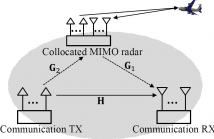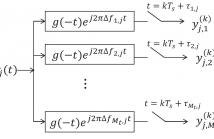- Read more about Optimal zero forcing precoder and decoder design for multi-userMIMOFBMCunder strong channel selectivity
- Log in to post comments
This paper investigates the optimal design of precoders or decoders
under a channel inversion criterion for multi-user (MU) MIMO filterbank
multicarrier (FBMC) modulations. The base station (BS)
is assumed to use a single tap precoding/decoding matrix at each
subcarrier in the downlink/uplink, resulting in a low complexity of
implementation. The expression of the asymptotic mean squared error
(MSE) for this precoding/decoding design in the case of strong
channel selectivity is recalled and simplified. Optimizing the MSE
- Categories:
 9 Views
9 Views- Read more about OPTIMAL OPTIMAL PILOT LENGTH FOR UPLINK MASSIVE MIMO SYSTEMS WITH PILOT REUSE
- Log in to post comments
- Categories:
 2 Views
2 Views- Read more about Low-Complexity Recursive Convolutional Precoding for OFDM-based Large-Scale Antenna Systems
- Log in to post comments
- Categories:
 5 Views
5 Views- Read more about Low-Complexity Recursive Convolutional Precoding for OFDM-based Large-Scale Antenna Systems
- Log in to post comments
Large-scale antenna (LSA) has gained a lot of attention recently since it can significantly improve the performance of wireless systems. Similar to multiple-input multiple-output (MIMO) orthogonal frequency division multiplexing (OFDM) or MIMO-OFDM, LSA can be also combined with OFDM to deal with frequency selectivity in wireless channels. However, such combination suffers from substantially increased complexity
- Categories:
 1 Views
1 Views
- Read more about A JOINT DESIGN APPROACH FOR SPECTRUM SHARING BETWEEN RADAR AND COMMUNICATION SYSTEMS
- Log in to post comments
A joint design approach is proposed for spectrum sharing between MIMO radar and MIMO communication systems. Radar transmit precoding and adaptive communication transmission are adopted, and are jointly designed to maximize signal-to-interference-plus-noise ratio (SINR) at the radar receiver subject to the communication system meeting certain rate and power constraints. We start with the design of a system in which knowledge of the target information is used. Such design can be used to benchmark the performance of schemes that do not use target information.
- Categories:
 23 Views
23 Views
We propose a novel distributed MIMO receiver structure that accounts for multiple carrier frequency offsets (CFOs) and multiple timing offsets (TOs). The proposed structure utilizes a bank of pulse matched filters (one per effective CFO) at each receive antenna, followed by an information symbol detector. Each filter in the bank is sampled at the symbol rate with sampling timing selected according to the corresponding TO. For the proposed receiver configuration, we derive the maximum likelihood (ML) detector for both coded (space-time block code) and uncoded distributed MIMO systems.
IcasspPoster.pdf
- Categories:
 6 Views
6 Views- Read more about LOW-COMPLEXITY BEAMFORMING DESIGNS OF SUM SECRECY RATE MAXIMIZATION FOR THE GAUSSIAN MISO MULTI-RECEIVER WIRETAP CHANNEL
- Log in to post comments
Poster for the paper 'Low-Complexity Beamforming Designs of Sum Secrecy Rate Maximization for the Gaussian MISO Multi-Receiver Wiretap Channel'.
Tang Yanqun's interests are in communication theory and signal processing, including MIMO systems, physical layer security, simultaneous wireless information and power transfer, visual light communications.
Email: tangyanqun@126.com.
- Categories:
 10 Views
10 Views- Read more about RATE OPTIMIZATION FOR MASSIVE MIMO RELAY NETWORKS: A MINORIZATION-MAXIMIZATION APPROACH
- Log in to post comments
- Categories:
 6 Views
6 Views- Read more about Low-Complexity Recursive Convolutional Precoding for OFDM-based Large-Scale Antenna Systems
- Log in to post comments
Large-scale antenna (LSA) has gained a lot of attention recently since it can significantly improve
the performance of wireless systems. Similar to multiple-input multiple-output (MIMO) orthogonal
frequency division multiplexing (OFDM) or MIMO-OFDM, LSA can be also combined with OFDM to
deal with frequency selectivity in wireless channels. However, such combination suffers from substantially
increased complexity proportional to the number of antennas in LSA systems. For the conventional
- Categories:
 4 Views
4 Views- Read more about Superimposed Pilots : An Alternative Pilot Structure to Mitigate Pilot Contamination in Massive MIMO
- Log in to post comments
Superimposed pilots are proposed as an alternative to time-multiplexed pilot and data symbols for mitigating pilot contamination in massive multiple-input multiple-output systems. Provided that the uplink duration is larger than the total number of users in the system, superimposed pilots enable each user to be assigned a unique pilot sequence, thereby allowing for a significant reduction in pilot contamination. Channel estimation performance in the uplink is further improved using an iterative data-aided algorithm.
- Categories:
 22 Views
22 Views